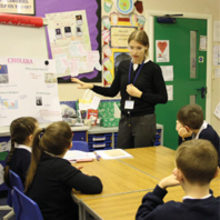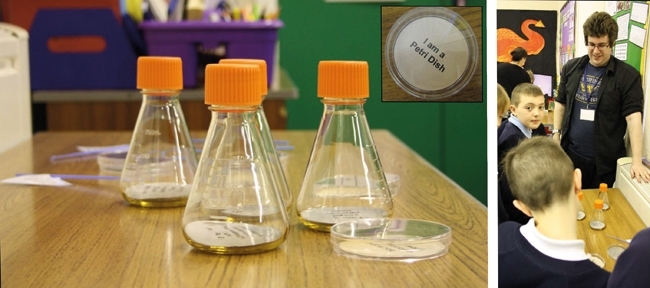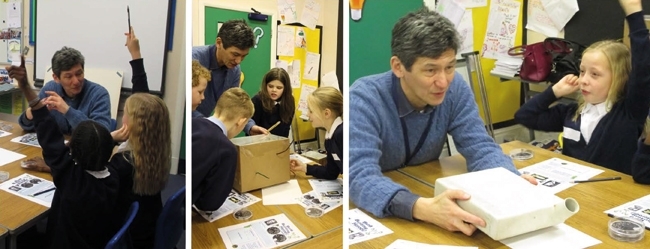Outreach: Primary School outreach – inspiring young minds with science
11 August 2015

Earlier this year, a research group from the Sir William Dunn School of Pathology at the University of Oxford decided to take a daring step out of the lab and go to Elm Wood Primary School in Middleton, to teach bacteriology to Year 5 (nine- and ten-year-old) children, as part of the School’s curriculum topic on the ‘History of Medicine’.
Researchers’ experience
Many outreach programmes are focused on teaching GCSE or A-level students but it is equally important to inform children at a young age about research. Our goal was not only to engage the children in discussion about microbiology, but also to incorporate a historical perspective, and integrate learning with their ongoing work.
We aimed to explore the notion of the scientific breakthrough itself as well as basic microbiology concepts. In collaboration with the class teacher, who provided essential guidance on how best to target our teaching to an audience significantly younger than our usual undergraduate medical students, we designed four different workstations. Each had a theme with an associated worksheet and activities incorporating cross-curricular challenges, such as measurement and descriptive word choices. We took inspiration from excellent online resources such as ‘Cholera and the Thames’, ‘E-bug’ and the Wellcome Library, and received some key advice from experts at the Natural History Museum, the University of Oxford and the Microbiology Society.
Groups of approximately six children attended each workstation for half an hour at a time. At the first station (Germ Detectives), children were asked to don their metaphorical detective hats and investigate the cholera epidemic in 19th century London. Plotting a map of infected individuals, we traced the outbreak to the infamous Soho water pump in the same way John Snow once did, with information on the deadly Vibrio bacterium provided throughout.
For the second task (Meet the Bacteria), the pupils were presented with micrographs and set about describing the size and shape of the bacteria while learning about the microbes’ natural niches and their contribution to health, agriculture and disease. This led to the question ‘Are these bacteria good or bad?’ with a focus on commensal and environmental organisms. In addition, the children had a chance to handle microbiology tools, such as Petri dishes, flasks and spreaders.
At the ‘Making Scientific Discoveries’ station, children could view a flea through a light microscope, and then see bacteria via a television screen, while learning how van Leeuwenhoek first spotted ‘animalcules’ using his own lenses in 17th century Holland. The children used their imagination to realise how it might feel to make such a discovery. The final station, ‘Bug Busting Heroes’, was designed to teach the pupils about the history of penicillin and its contribution towards world health, ending in a vivid demonstration of a lysing bacterial cell: pipecleaner-fimbriated balloons bursting, complete with rubber band ‘DNA’.

Perhaps more important than the presentation of science, however, was the discussion each of our scientists had with the children and staff. The children had the opportunity to share their impressions of the activities and what they learned during the day. There were some very interesting questions about people who inspired us when we were their age and what our latest ‘lab invention’ was, as well as some very entertaining questions. For example, one of the boys asked what it takes to become the boss; another asked if it is really necessary to do all their homework in order to become a scientist – which was met with a resounding YES!
Our goal was to engage the children and convince them that they themselves could join the world of research and become the scientists of the future. However, it had a broader impact on everyone who was involved because the teachers and research group members were as inspired as the children. It was an incredible privilege to be part of this experience and we are thankful to the teachers and the headmaster who supported us throughout the day. For us, it was a first taste of outreach, which will hopefully grow into a long-term partnership with further opportunities for the schoolchildren. If even one of them feels inspired to take up a career in research, we will have achieved our objective.
The school’s perspective
When the opportunity arose for a team of scientists to come and teach the children, we were thrilled. Teaching needs to be about having high expectations for the children and exposing them to new and interesting information. Having the experts teach them was fantastic – you know that the children are getting the highest level of understanding in that field!
Prior to the visit, we had several meetings with the scientists to discuss appropriate materials and agree on the day’s activities, which was critical to the success of the day. It was important for us to know what was being brought to school. Equally, it was important for the scientists to realise the level of understanding of Year 5 (Key Stage 2) children, so that activities and worksheets could be designed appropriately. The discussions helped to clarify feasible activities and identify realistic learning objectives to finalise the four activities. On a practical level we also worked out the logistics of the day in terms of safety and risk assessment, group sizes, how to cater for children with special physical or educational needs, and the classroom layout, set-up and timing, so that activities fitted around lunch breaks and playtime, and that the workstations were suitably arranged. Earlier in the term, Year 5 had learned about some important breakthroughs in science, such as Jenner and vaccination, and the discovery of antibiotics. This meant that the outreach provided continuity in learning and reinforced the children’s understanding of important events.
When the day finally arrived, the children were, of course, extremely excited. We began with a short teacher-led introductory session to explain the practical aspects and the main learning objectives. It was an absolute pleasure to watch the class not only participate, but show a good understanding of the science they were being taught. Giving the children the opportunity to use ‘real life’ equipment and meet actual scientists ignited their enthusiasm for knowledge (and Dr Florey´s microscope created awe in both children and staff alike). They constantly wanted to know more and impressed everyone with their pertinent and interesting questions. The researchers were very impressed when the children already knew not only that Fleming discovered penicillin but that Florey and his team at the Dunn School were crucial to its extraction and production! We closed the session with a Q&A so we could gauge what the children had learned. Questions about the scientists’ own discoveries and what motivated them to do research showed how much the children had understood and been inspired by the day’s activities.

The outreach day was a unique experience for many of the children. They were able to see that scientists are not crazy men in white coats with wild hair, but adults who had, as children, worked hard and followed their passion in life. In particular, as male and female scientists were involved, it provided strong role models and showed that there is a purpose to working hard at school! The day was so successful that there are plans to make this an annual event for Year 5. There has also been discussion about reuniting the Oxford team with the children when they are in Year 6, to further their knowledge and understanding and hopefully deepen their love of science, ready for Secondary School.
We could write reams about the impact that day had on the children but it is best when you hear it from them:
“I loved everything. All the stuff we got to see. What was the best was that we actually got to touch all the things and use them, just like the professors do in their lab.” Luke, age 10.
“I want to be just like the professors when I grow up. Then I can go to Oxford and discover really cool stuff like new bacteria and everyone will be happy. I love science and I am going to be a scientist.” Rafaela, age 10.
When we hear the enthusiasm and passion in the children’s responses, as teachers, we could not wish for anything more.
Acknowledgements
We are grateful to Amoret Spooner for slides, to Alan Todd for the loan of the eyepiece camera and Kim Hardie for helpful ideas. We thank all those who provided help and advice in preparation for the day as well as the staff and pupils of Elm Wood Primary School for their warm welcome and stimulating environment.
MARIYA LOBANOVSKA, GARETH MCVICKER, RACHEL M. EXLEY AND CHRISTOPH M. TANG
Sir William Dunn School of Pathology, University of Oxford, Oxford OX1 3RE, UK
RUTH H. EXLEY AND DAVID WILLIS
Elm Wood Primary School, Elm Street, Middleton, Manchester M24 2EG, UK
FURTHER READING
Cholera and the Thames. Last accessed 24 June 2015.
Ebug. Last accessed 24 June 2015.
